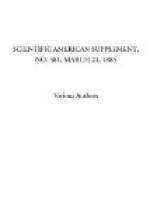As stated above, the torpedo is self-propelling, the necessary energy being stored up in liquefied carbonic acid contained in a cylindrical vessel, E, carried by the torpedo. The vessel, E, communicates, by means of a small bent pipe extending nearly to its bottom, with a small chamber, B, the passage of the liquid being controlled by means of the cock or tap, F. The chamber, B, is in communication, by means of a small aperture, with the nozzle, G, of an injector, T, constructed on the ordinary principles. The liquid as it passes into the chamber, B, volatilizes, and the gas passes through the nozzle of the injector, which is surrounded by water in direct communication with the sea by means of the opening, W. The gas imparts its energy in the well-known manner to the water, being itself entirely or partially condensed, the water thus charged with carbonic acid gas being forced through the combining cone of the injector at a very high speed and pressure. Preferably the water is here divided into two streams, each driving a separate rotary motor or turbine, H, themselves driving twin screws or propellers, I. The motors exhaust into the hollow shafts, J, of the propellers, which are extended some distance beyond the propellers, so that the remaining energy of the water may be utilized to aid in propelling the torpedo on the well known principle of jet propulsion. The torpedo is preferably steered by means of the twin screws. A disk or other valve, A, is pivoted in an aperture in a diaphragm dividing the outlet of the injector, and is operated by means hereafter described, so as to diminish the stream of water on one side and increase it on the other, so that one motor, and consequently the corresponding propeller, is driven at a higher speed than the other, and so steers the torpedo.
[Illustration: PAULSON’S self propelling and steering torpedo.]
The valve, A, is operated automatically by the following arrangement: A mariner’s compass, P, placed in the head of the torpedo has its needle connected to one pole of a powerful battery, D. A dial of non-magnetic material marked with the points of the compass is capable of being rotated by the connections shown. This dial carries two insulated studs, p, each electrically connected with one terminal of the coils of an electromagnet, K, whose other terminal is connected to the other pole of the battery. These two magnets are arranged on opposite sides of an armature fixed on a lever operating the disk or valve, A. Before launching the torpedo the dial is set, so that when the torpedo is steering direct for the object to be struck, or other desired point, one end of the needle of the compass, P, is between the steeds, p, but contact with neither, the needle of course pointing to the magnetic north. Should the torpedo however deviate from this course, the needle makes contact with one or other of the studs according to the direction in which the




